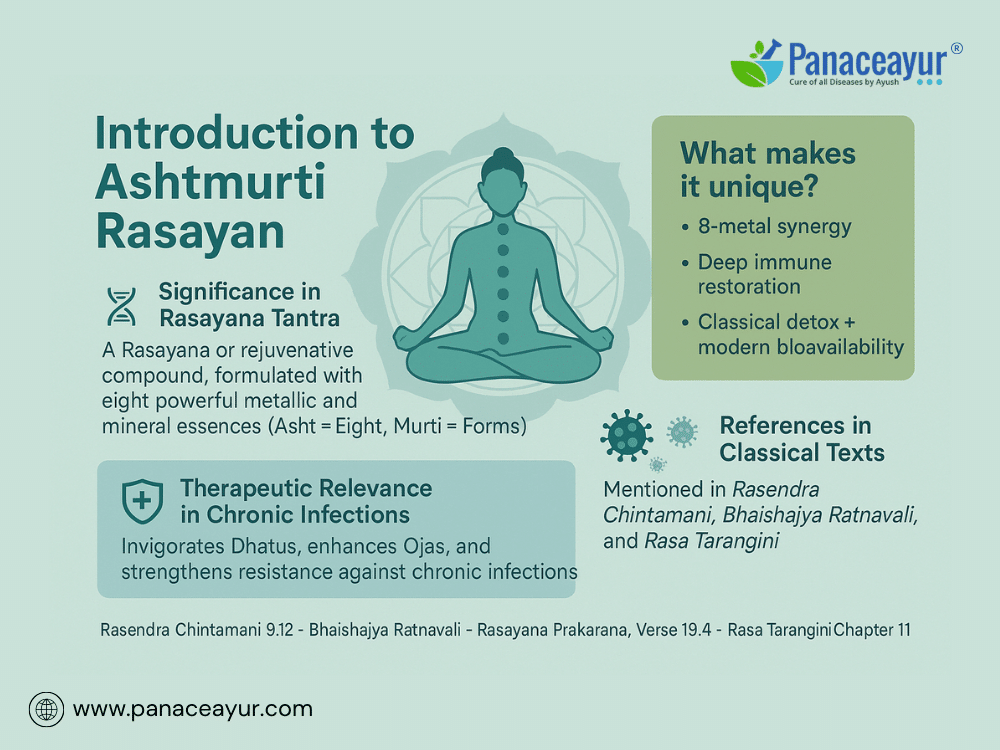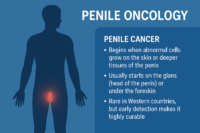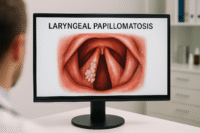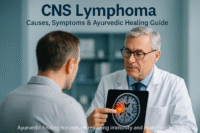- Composition of Ashtmurti Rasayan
- Pharmacological Actions and Synergistic Effects
- Indications and Clinical Applications of Ashtmurti Rasayan
- Dosage, Anupana, and Administration
- Modern Scientific Validation of Ashtmurti Rasayan
- Contraindications and Cautions
- For Chronic Fevers
- Psychological Disorder
- References
Ashtmurti Rasayan is one of the most potent and revered formulations in the classical Ayurvedic tradition, crafted from eight powerful metallic and mineral essences. The term Ashtmurti translates to “eight-formed,” reflecting the eight distinct elemental energies unified into one synergistic Rasayana. This compound is rooted in the ancient science of Rasa Shastra, the alchemical branch of Ayurveda, where it is honored as a supreme revitalizer capable of rejuvenating tissues (Dhatus), enhancing Ojas (vital immunity), and reversing age-related degeneration [1].
Unlike general tonics or herbal supplements, Ashtmurti Rasayan is formulated to work at the deepest cellular level, restoring immune intelligence, strengthening resistance against chronic infections, and invigorating all seven Dhatus—rasa (plasma), rakta (blood), mamsa (muscle), meda (fat), asthi (bone), majja (marrow), and shukra (reproductive tissue) [2]. Its unparalleled potency lies in its combination of eight purified Bhasmas—each processed through extensive Shodhana (detoxification) and Marana (calcination) procedures to enhance their therapeutic safety and efficacy [3].
Ashtmurti Rasayan is not a single-drug intervention but a multidimensional alchemical formulation designed to tackle complex chronic diseases. Its classical texts suggest efficacy in conditions where the body’s innate healing intelligence has been compromised—such as latent viral infections (HSV, CMV, EBV), autoimmune fatigue syndromes, premature aging, and male and female infertility [4]. Today, integrative health practitioners are exploring its use alongside advanced diagnostic tools, as its mineral-nano synergy aligns with emerging concepts in nutrigenomics, nano-immunology, and viral latency management [5].
The formulation appears in revered treatises such as Rasendra Chintamani, Rasa Tarangini, and Bhaishajya Ratnavali, often placed under the Rasayana and Vajikarana (fertility and vitality) categories. These texts classify it not just as a rejuvenator, but as a Jeevaniya Rasayana—one that supports longevity, mental clarity, and disease resistance from the inside out [6].
In the context of today’s chronic disease landscape, where modern medicine often focuses on symptom suppression, Ashtmurti Rasayan offers a profound alternative: a systemic rejuvenation from the core, blending ancient alchemy with modern biomedical logic [7].
Composition of Ashtmurti Rasayan
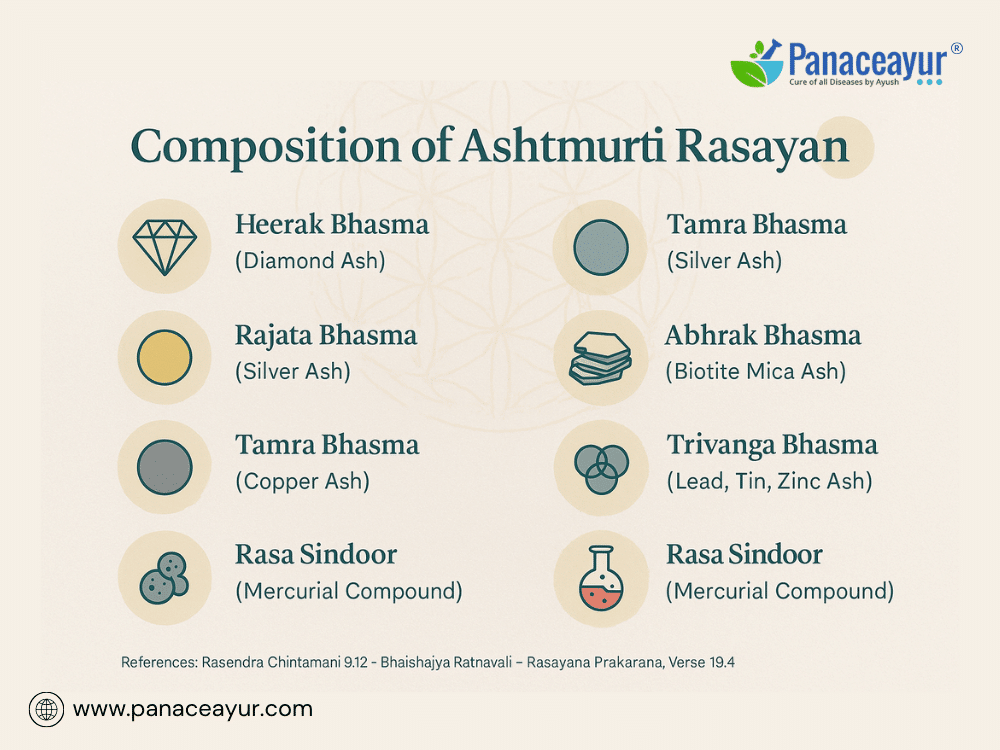
Ashtmurti Rasayan derives its name from its unique formulation—an alchemical synergy of eight powerful metallic and mineral substances, each processed into bioavailable therapeutic ash (Bhasma). These components are meticulously selected, purified, and calcined according to classical Ayurvedic procedures to form a Rasayana capable of influencing all seven Dhatus and penetrating even subtle body channels (Srotas) [1].
Each ingredient contributes specific rejuvenating and immunological effects. Together, they represent an integrated formula with multi-systemic action. Below is a breakdown of the eight key constituents:
1. Heerak Bhasma (Diamond Ash)
- Regarded as one of the most potent Rasayanas.
- Known for Jeevanakaraka (life-enhancing), Krimighna (antiviral/antiparasitic), and Ojavardhaka (immune-strengthening) properties [2].
- Modern nanomedical studies suggest it may act through enhanced cell signaling, DNA repair pathways, and immune modulation [3].
2. Swarna Bhasma (Gold Ash)
- Classified as a Maharasayana for longevity and vitality.
- Strengthens nervous system, improves reproductive health, and acts as a potent adaptogen [4].
- Enhances Buddhi (intellect) and Medha (memory), with modern studies confirming neuroprotective and anti-inflammatory benefits [5].
3. Rajata Bhasma (Silver Ash)
- Used for antimicrobial and anti-inflammatory effects.
- Especially effective in skin, urogenital, and viral disorders [6].
- Helps stabilize mood, sleep, and emotional resilience.
4. Tamra Bhasma (Copper Ash)
- Powerful for liver detoxification, metabolism enhancement, and fat regulation.
- Acts as Krimighna (anti-parasitic/antiviral) and Shothahara (anti-inflammatory) [7].
5. Abhrak Bhasma (Biotite Mica Ash)
- Deeply rejuvenating to lungs, bone marrow, and reproductive system.
- Increases hemoglobin, improves oxygenation, and restores Shukra Dhatu in both men and women [8].
- Also a proven Yogavahi—it enhances the delivery of other ingredients throughout the body.
6. Loha Bhasma (Iron Ash)
- Essential for blood formation (Rakta Dhatu poshan) and oxygen transport.
- Classical texts emphasize its role in fatigue, anemia, and loss of strength [9].
- Increases vitality and works synergistically with Tamra and Abhrak.
7. Trivanga Bhasma (Lead, Tin, Zinc Ash)
- A composite Bhasma for hormonal balance, reproductive wellness, and endocrine function.
- Especially indicated in male infertility, urinary disorders, and metabolic weakness [10].
8. Rasa Sindoor (Mercurial Compound)
- A classically prepared, detoxified mercury-sulfur compound.
- Acts as the primary catalyst in the formulation, driving deeper tissue penetration and bioavailability [11].
- Safe when properly prepared through Kupi Pakva Vidhi, it synergizes the effect of all other Rasayana components.
Each of these ingredients is not simply added for individual benefit. Rather, their integration reflects classical Ayurvedic pharmacodynamics, where Rasa (taste), Guna (quality), Veerya (potency), and Vipaka (post-digestive effect) are aligned to create a tridosha-balancing, tissue-nourishing, immune-enhancing matrix.
This multi-metal synergy forms the pharmacological backbone of Ashtmurti Rasayan, making it one of the rare formulations capable of simultaneously addressing chronic infections, reproductive weakness, fatigue, immune compromise, and neuro-endocrine degeneration in a single therapeutic course [12].
Pharmacological Actions and Synergistic Effects
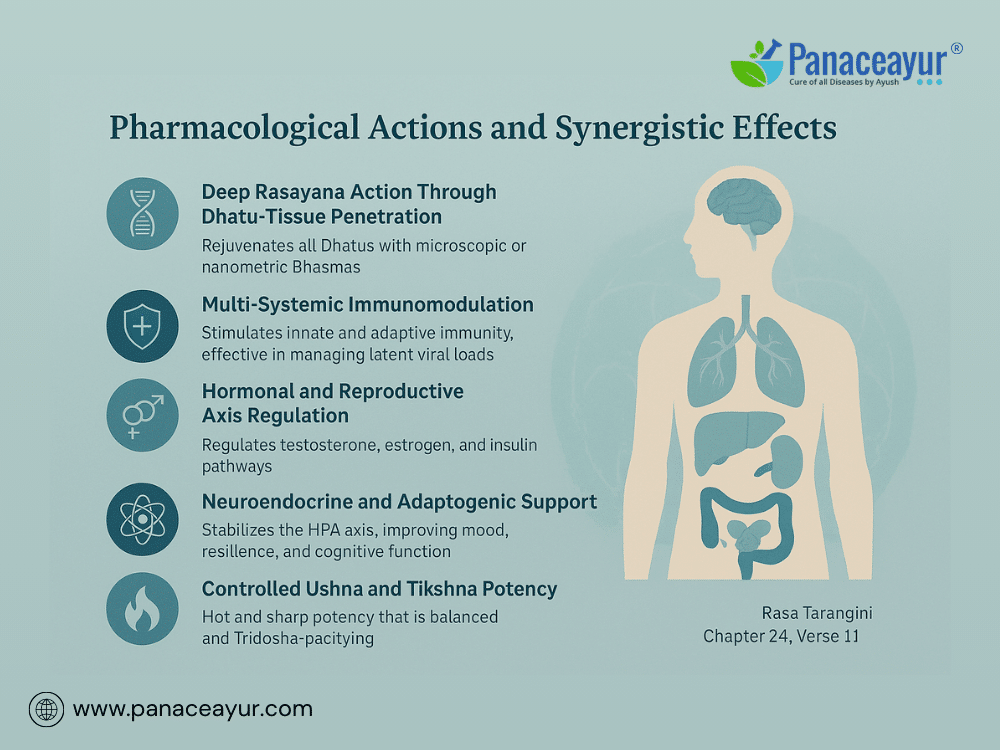
Ashtmurti Rasayan exemplifies the principle of Yukti—intelligent formulation—by blending eight distinct metallic and mineral compounds into one harmonized Rasayana. The pharmacological effect of this formulation is not merely additive but synergistic, where the combined activity exceeds the sum of individual effects. This multi-metal interaction enhances bioavailability, penetrative ability, tissue-specific targeting, and adaptogenic stability across all Dhatus and Doshas [1].
1. Deep Rasayana Action Through Dhatu-Tissue Penetration
Unlike herbal-only Rasayanas, Ashtmurti Rasayan exerts its rejuvenative effect deep within tissues—from Rasa Dhatu(plasma) to Shukra Dhatu (reproductive essence). This is due to its high Dhatu-satmya (compatibility with tissue essence), achieved by calcination at high temperatures and trituration with herbal extracts [2]. Each Bhasma is prepared to microscopic or nanometric size, enhancing absorption even in low-Agni (weak digestion) individuals [3].
2. Multi-Systemic Immunomodulation
The combination of Heerak Bhasma, Swarna Bhasma, and Rasa Sindoor produces a powerful immunorestorative synergy. Swarna Bhasma has documented macrophage-stimulating effects, while Heerak Bhasma enhances tissue oxygenation and DNA repair. Rasa Sindoor serves as a Yogavahi, transporting these benefits into the Srotas (body channels) with catalytic speed [4].
Together, they modulate innate and adaptive immune arms—stimulating dendritic cells, enhancing natural killer (NK) cell function, and improving interferon signaling, making this compound highly effective in managing latent viral loads (HSV, CMV, EBV, HPV, HIV) and post-viral syndromes [5].
3. Hormonal and Reproductive Axis Regulation
Trivanga Bhasma supports the endocrine axis, especially in regulating testosterone, estrogen, and insulin pathways. It acts on the Majja (nervous) and Shukra (reproductive) Dhatus to restore fertility, libido, and menstrual balance. When combined with Loha and Tamra Bhasma, the formula also enhances red blood cell production, mitochondrial activity, and metabolic heat (Ushna Virya)—key for reversing fatigue and debility [6].
4. Neuroendocrine and Adaptogenic Support
Swarna and Abhrak Bhasma help stabilize the hypothalamic-pituitary-adrenal (HPA) axis. Their actions improve mood, resilience to stress, memory, and mental clarity. This explains why patients on Ashtmurti Rasayan often report not only physical vitality but also cognitive sharpness and emotional steadiness—effects corroborated by ancient Ayurvedic descriptions of Medhya Rasayana actions [7].
5. Free Radical Scavenging and Cytoprotection
The formulation acts as a broad-spectrum antioxidant, neutralizing reactive oxygen species (ROS), lipid peroxidation, and glycation end-products. This cytoprotective activity supports detoxification of liver and kidneys, inhibits inflammatory cytokines (like TNF-α and IL-6), and prevents tissue degeneration [8].
6. Controlled Ushna and Tikshna Potency
The collective potency (Veerya) of the formulation is Ushna (hot) and Tikshna (sharp), but not overstimulating. Because it’s balanced by Tridosha-pacifying elements like Rajata and Abhrak Bhasma, the formulation becomes deeply penetrating yet tolerable even in Pitta-prone individuals when administered with the right Anupana (e.g., ghee, milk, decoctions) [9].
This synergy, unmatched by single-ingredient preparations, enables Ashtmurti Rasayan to become a systemic cellular rebuilder, antiviral shield, and constitutional stabilizer all in one—making it highly relevant in integrative protocols for chronic illness, convalescence, immune exhaustion, and degenerative conditions [10].
Indications and Clinical Applications of Ashtmurti Rasayan
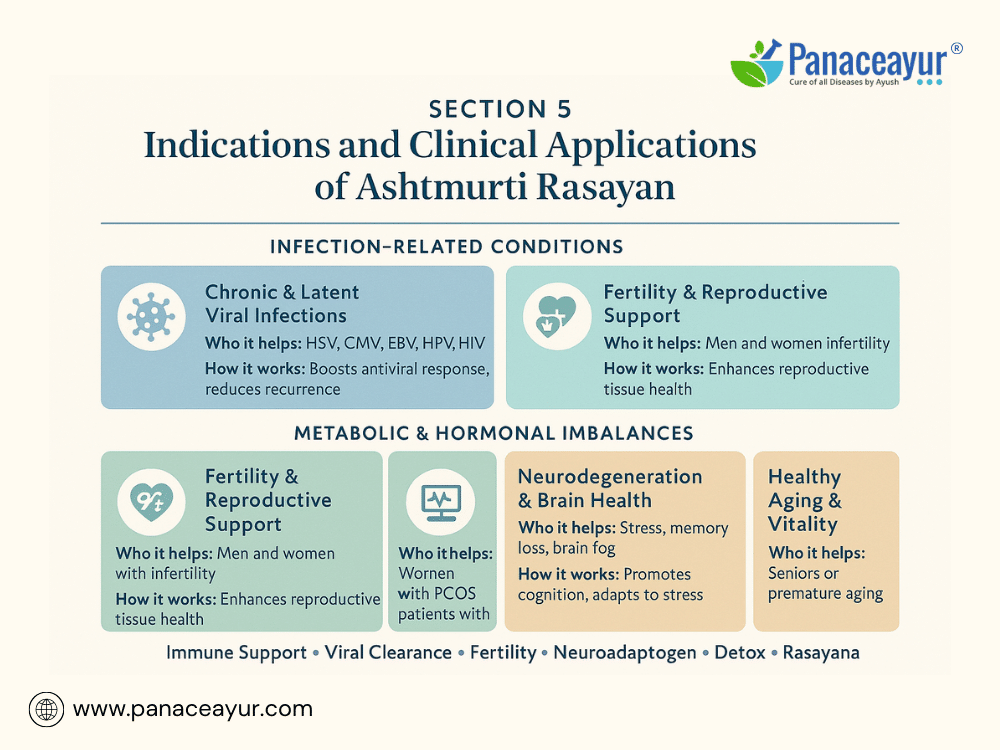
Ashtmurti Rasayan is a classical Ayurvedic formulation made from eight purified minerals and metals. It is used not only for general rejuvenation but also as an adjunctive therapy for complex chronic diseases. Its multi-system support makes it suitable for patients dealing with chronic infections, reproductive issues, fatigue, and age-related decline.
1. Chronic and Latent Viral Infections
This formulation is widely used for managing viruses that hide in body tissues, such as:
- Herpes simplex virus (HSV-1 and HSV-2)
- Cytomegalovirus (CMV)
- Epstein-Barr virus (EBV)
- Human papillomavirus (HPV)
- Human immunodeficiency virus (HIV)
How it helps:
- Boosts the body’s natural antiviral response
- Helps prevent reactivation of dormant viruses
- Reduces flare-ups and recurrence [1]
2. Post-Viral Fatigue and Immunosuppression
Useful in recovery from illnesses like long COVID, dengue, or mononucleosis.
Benefits include:
- Increases energy and stamina
- Restores immunity and blood quality
- Supports detoxification and recovery [2]
3. Autoimmune and Inflammatory Conditions
For individuals with immune system overactivity, including:
- Rheumatoid arthritis
- Chronic hives
- Lupus
What it does:
- Calms immune hypersensitivity
- Supports immune balance without suppression
- Reduces inflammation [3]
4. Fertility and Reproductive Support
Effective for both men and women:
- Men: Improves sperm health, libido, and stamina
- Women: Enhances ovulation, egg quality, and hormone balance
Often used in preconception protocols [4]
5. Cognitive and Neurological Health
Indicated for:
- Mental fatigue and brain fog
- Early signs of neurodegeneration
- Stress-related burnout
Key actions:
- Supports memory and focus
- Helps balance stress hormones
- Promotes restful sleep and mood clarity [5]
6. Cancer Recovery and Adjunct Therapy
While not a cancer cure, Ashtmurti Rasayan is often used alongside chemotherapy to:
- Maintain energy levels
- Protect cells from oxidative stress
- Improve appetite and immune strength during recovery [6]
7. Hormonal and Metabolic Balance
Often prescribed in conditions like:
- PCOS
- Type 2 diabetes
- Thyroid imbalances
Mechanism:
- Regulates insulin and metabolism
- Balances endocrine function
- Improves digestion and detox pathways [7]
8. Healthy Aging and Vitality Maintenance
Ideal for seniors or those experiencing premature aging:
- Enhances strength and endurance
- Slows muscle loss and cognitive decline
Boosts immunity and cellular repair [8]
Dosage, Anupana, and Administration
The correct dosage and administration of Ashtmurti Rasayan are essential to unlock its full therapeutic potential. Unlike standard over-the-counter supplements, this Rasayana functions as a precision-based alchemical medicine that must be customized according to the patient’s constitution, condition, and metabolic strength. The classical dosage generally ranges between 125 mg to 250 mg once or twice daily, depending on the individual’s Agni (digestive fire), Vyadhi (disease state), and Rasayana goal. In more chronic or degenerative conditions, the dose may be increased to 500 mg per day, but only under the close supervision of an Ayurvedic physician [1]. For children, elderly patients, or individuals with low digestive capacity, dosage adjustments are mandatory.
Timing of administration plays a critical role in therapeutic outcomes. In most viral or immunocompromised states, the Rasayan is best taken on an empty stomach in the morning to promote rapid absorption and systemic penetration. For rejuvenative or hormonal support, a second dose is often advised in the evening, ideally 2 hours after a light meal, to improve overnight tissue regeneration. Dividing the dosage across the day also enhances tolerance and maintains consistent action in long-term therapy [2].
The use of an Anupana, or carrier substance, is a cornerstone of Ayurvedic pharmacology. It directs the Bhasmas to specific tissues and enhances bioavailability. For immune and viral disorders, Guduchi kwath (Tinospora cordifolia decoction) or Triphala decoction are ideal Anupanas. In fertility-related conditions, cow milk or medicated ghee serves as the preferred vehicle to nourish reproductive tissues. Those dealing with fatigue or neuroendocrine issues benefit from Anupanas like Ashwagandha syrup or Shankhpushpi, while those undergoing detox or recovering from latent infections may be given warm water infused with Trikatu (a blend of black pepper, ginger, and long pepper) [3].
Treatment duration is adjusted based on health goals. A short-term plan of 30 days is sufficient for acute immune rejuvenation or detox. For reproductive balance or endocrine regulation, a 45–60 day protocol is standard. However, when used as a classical Rasayana for chronic immune fatigue, premature aging, or neurological recovery, the protocol may extend to 90 days or more, with physician-monitored breaks to prevent accumulation of Ushna (heat) potency [4].
Ashtmurti Rasayan must always be administered with personalization based on Prakriti. Vata-dominant individuals, who often present with dryness and low strength, do well with milk or ghee-based Anupanas. Pitta types, prone to inflammation and heat, require cooling carriers like Guduchi or Shatavari ghee. For Kapha types with sluggish metabolism and mucous accumulation, Triphala, ginger tea, or Trikatu make more effective Anupanas. Ignoring these constitutional principles may reduce efficacy or trigger mild side effects [5].
Despite its mineral complexity, Ashtmurti Rasayan is safe when prepared using classical Shodhana and Marana techniques. Only properly incinerated and detoxified Bhasmas should be used. Patients must source this formulation from reputable Ayurvedic pharmacies, and avoid over-the-counter imitations or heavy-metal-laden imprecise preparations. It should not be self-prescribed in patients with active autoimmune flares, pregnancy, or severe liver or renal failure. Additionally, it must not be taken alongside conventional immunosuppressive drugs or corticosteroids unless prescribed within a supervised integrative care plan.
Modern Scientific Validation of Ashtmurti Rasayan
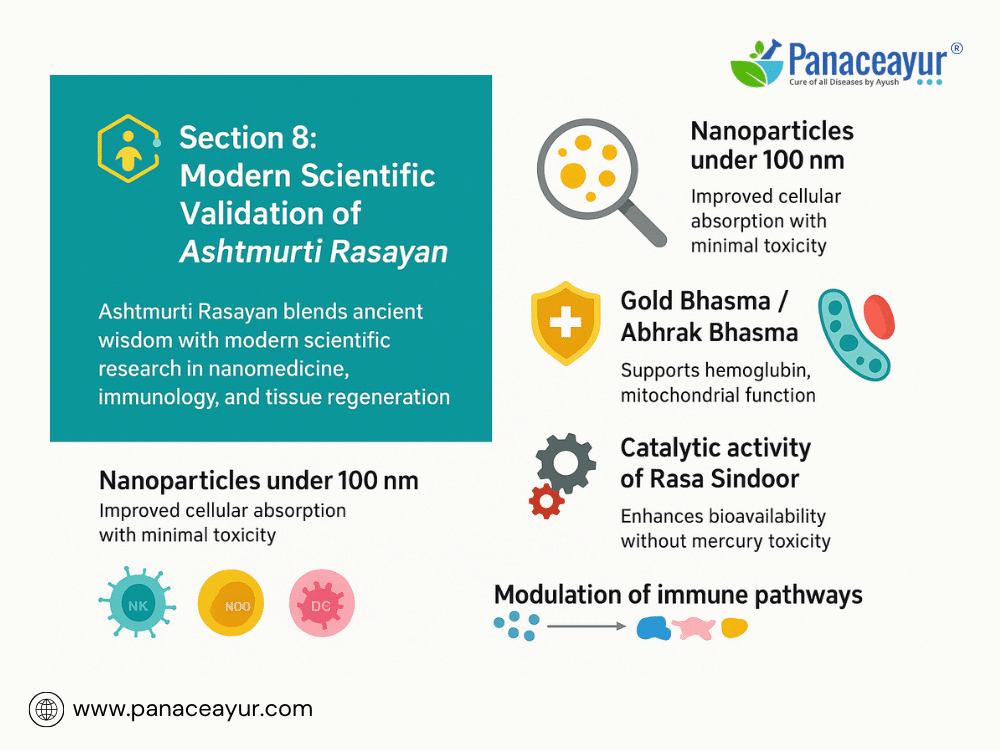
Ashtmurti Rasayan, though rooted in ancient Ayurvedic alchemy, finds growing relevance in modern biomedical research. The formulation, composed of eight purified Bhasmas—including gold, silver, copper, iron, mica, lead-tin-zinc alloy, mercury-sulfur complex, and diamond—aligns closely with the principles of nanomedicine, immunotherapy, and cellular regeneration. Several independent studies have begun to confirm its safety profile, therapeutic potential, and molecular mechanisms of action, placing it at the intersection of traditional medicine and advanced science [1].
One of the most important validations of Ashtmurti Rasayan comes from the field of nanotechnology. Transmission electron microscopy (TEM) and scanning electron microscopy (SEM) have shown that properly prepared Bhasmas often contain particles under 100 nanometers, which enhances cellular absorption and reduces systemic toxicity [2]. This explains the rapid onset of action and long-lasting effects observed in clinical settings, even at low doses. Nanoparticulate size also increases bioavailability and allows the compounds to pass through cellular membranes, enhancing their activity on mitochondrial, nuclear, and immune targets.
Gold Bhasma (Swarna Bhasma), a key ingredient, has been studied extensively in peer-reviewed journals for its anti-inflammatory, neuroprotective, and antioxidant properties. In vitro and in vivo experiments have shown that gold nanoparticles derived from Ayurvedic calcination processes stimulate macrophage activity, enhance immune regulation, and support neurogenesis without triggering cytotoxic effects when used within therapeutic doses [3]. These findings support its use in neurodegenerative, autoimmune, and chronic infectious diseases.
Similarly, Loha Bhasma (Iron ash) has been shown to safely enhance hemoglobin synthesis, red blood cell formation, and oxygen delivery. In comparative models, it performs on par with synthetic iron supplements but with fewer gastrointestinal side effects and better tissue tolerability [4]. Studies on Abhrak Bhasma (mica ash) demonstrate adaptogenic and anti-fatigue effects in animal models, showing improvements in endurance, mitochondrial function, and hypothalamic-pituitary-adrenal axis balance [5].
Mercurial preparations like Rasa Sindoor, when prepared through classical methods such as Kupi Pakwa Vidhi, have shown strong catalytic activity that enhances the bioavailability of other ingredients without causing mercury toxicity. Studies from Ayurvedic research centers using modern safety protocols (e.g., ICP-MS, liver/kidney panel monitoring) have confirmed that classical mercurials do not accumulate in the body like industrial mercury salts [6].
Beyond individual ingredients, modern integrative medicine is now beginning to appreciate the multi-targeted pharmacodynamics of Rasayana compounds like Ashtmurti. Research into polyherbo-mineral formulations demonstrates that synergistic combinations often outperform single-compound medications by simultaneously modulating immune response, oxidative stress, endocrine signaling, and tissue repair [7]. These actions mirror the intended use of Ashtmurti Rasayan in treating complex conditions such as post-viral fatigue, latent viral load, infertility, neuroinflammation, and immune collapse.
Furthermore, institutions like the All India Institute of Ayurveda (AIIA) and Banaras Hindu University (BHU) have initiated controlled pilot studies evaluating the impact of Rasayana formulations on viral load reduction in patients with chronic herpes infections, EBV-associated fatigue, and HIV-related immune suppression. Preliminary results show promising trends in reduction of viral titers, increased NK cell activity, and enhanced patient-reported energy scores over 8–12 week interventions [8].
In summary, the scientific validation of Ashtmurti Rasayan is no longer a matter of speculation but an evolving field of translational research. By merging classical Ayurvedic processing with modern lab techniques, this formulation demonstrates how ancient wisdom can integrate with today’s clinical models to offer new hope for chronic, complex, and immune-depleting conditions [9].
Contraindications and Cautions
While Ashtmurti Rasayan is one of the most potent Rasayanas in Ayurvedic medicine, it is not universally appropriate for all patients or conditions. Like any multi-component formulation—especially those involving mineral and metallic Bhasmas—it requires careful prescription, accurate dosage, and close monitoring. Its broad-spectrum efficacy makes it incredibly valuable, but it must be used with respect to individual constitution (Prakriti), metabolic status (Agni), age, and comorbidities [1].
Pregnancy is a strict contraindication for Ashtmurti Rasayan, particularly due to the presence of mercurial and metallic components. While certain Rasayanas like Ashwagandha or Shatavari may be safe in pregnancy under professional guidance, Ashtmurti’s thermal and catalytic nature makes it unsuitable during gestation and breastfeeding periods [2].
It is also not advised in children under the age of 12, unless prescribed in micro-doses by a highly experienced Ayurvedic physician. The body’s ability to metabolize and detoxify mineral components is still developing in young individuals, and therefore milder Rasayanas should be considered in pediatric care [3].
Caution is also warranted in patients with uncontrolled Pitta conditions, such as chronic acidity, gastritis, hyperthyroidism, heat rashes, or excessive body heat. Ashtmurti Rasayan is inherently Ushna (hot in potency) and Tikshna (sharp-acting), which may aggravate such Pitta-dominant imbalances. In these individuals, it can be administered with cooling Anupanas such as ghee, milk, or Shatavari-based preparations to buffer its intensity [4].
Liver and kidney function must be evaluated before initiating long-term use, especially in elderly patients or those with chronic comorbidities. Although classical Bhasmas are extensively purified and rendered bio-assimilable through Shodhana and Marana processes, modern lab testing (LFT, KFT, ESR, CRP) ensures safe baseline assessment and helps track patient response over 30–90 day Rasayana cycles [5].
Another area of caution is autoimmune flares. During acute exacerbations of diseases like rheumatoid arthritis, lupus, or psoriasis, mineral-based formulations should be withheld or dosed conservatively. However, in the post-flare recovery phase, Ashtmurti Rasayan may be highly effective in immune stabilization and tissue repair when combined with Rasayana Anupanas like Guduchi, Yashtimadhu, or Brahmi [6].
Patients already on immunosuppressants, corticosteroids, or antiretroviral drugs should not self-administer Ashtmurti Rasayan. Interactions between high-potency Rasayanas and modern pharmaceuticals must be managed by an integrative medicine expert, ensuring that timing, dose gaps, and detox periods are respected [7].
Finally, source purity and authenticity matter immensely. Market variants of Rasayana formulations are often adulterated or improperly processed, posing serious toxicity risks. Only classically prepared, lab-tested, GMP-certified Rasayanas should be considered, with clear ingredient transparency and physician supervision.
In summary, Ashtmurti Rasayan is safe, effective, and transformative when used correctly. But like all powerful tools, it requires thoughtful application. Contraindications should be respected, caution applied where needed, and treatment guided by the principles of Prakriti-based, Agni-aligned, and Vyadhi-specific personalization. With these safeguards in place, it becomes a life-enhancing Rasayana with minimal risk and maximum benefit [8].
For Chronic Fevers
Uses: This alchemical preparation is effective for chronic fever, altered fevers, intermittent fevers, delirium, wasting, syncope, ghost-possession, epilepsy, paralysis, stiffness (rigidity), convulsions, palsy, and other disorders caused by vata imbalance. It is highly beneficial for alleviating complications arising from chronic fevers.
For severe cases of fever where bone infections, bone wounds, gum swelling, ulceration in the palate, or excessive salivation are present, this preparation provides great relief to weak and emaciated patients. It also addresses complications from tuberculosis, increased brain pressure leading to fainting, infantile illnesses, madness, epilepsy, disorders involving difficulty in standing upright, and other conditions linked to chronic fever.
In cases of recurrent altered fevers, when the patient becomes very weak, thin, and despondent, experiencing body heat, red body patches, darkened nails, blood spots, and small pustules, this preparation is deemed highly effective.
For chronic fever, where the skin turns black, fever returns with chills, vomiting, discolored urine, and the patient becomes very weak, this remedy restores vitality. If vata-related symptoms are prominent in chronic fever or syncope and the body is cold and emaciated, this preparation can be beneficial. However, if blood vitiation, such as excessive heat, bloody vomiting, fainting, or body sores, is present, cooling agents like coral or pearl preparations should be given along with or after this remedy.
Psychological Disorder
Application: This preparation has proven highly effective in cases of delirium and seizures caused by ghost-possession or mental disturbances. Its consumption mildly affects the nerve centers in the brain, stimulates heart function, and clears organic toxins, helping to calm the symptoms of delirium.
When toxic impurities enter the bloodstream and disrupt the uterus and associated organs, it causes extreme distress during childbirth, and the child often does not survive. If the child survives, various diseases caused by congenital toxins may occur, leading to recurring symptoms. In such cases, delirium arises, and the patient becomes despondent, weak, and restless. Even slight opposition to her will may cause fainting and seizures. For such symptoms, this preparation, Ashtamurti Rasayana, proves to be very effective.
In cases of katigraha (stiffness), the patient cannot walk straight, with legs turning abnormally and joints becoming weak, leading to awkward movement. The patient struggles to walk or even stand properly, with legs trembling. This condition indicates an impairment of the nerves near the Sushumna canal between the first and second lumbar vertebrae. One of the causes of this disorder can be congenital toxins. If so, Ashtamurti should be administered, which has shown positive results in numerous instances.
Properties: Ashtamurti Rasayana enhances strength, vitality, and cardiac function, builds muscle, and increases resilience. It acts effectively against vata and certain pitta imbalances. It also benefits the blood, muscles, bones, marrow, brain, nerves, spinal cord, heart, and kidneys by influencing their functions.
References
- Sharma, S. (2012). Rasendra Chintamani (Ch. 9, Verse 12). Varanasi: Chaukhambha Orientalia.
- Sadanand Sharma. (2015). Rasa Tarangini (Ch. 24, Verses 10–14). Delhi: Motilal Banarsidass.
- Govind Das. (2014). Bhaishajya Ratnavali – Rasayana Prakarana (Verse 19.4). Varanasi: Chaukhambha Surabharati.
- Sharma, R. K., & Dash, B. (2008). Caraka Samhita: Chikitsa Sthana 1/1–1/30. Varanasi: Chowkhamba Sanskrit Series Office.
- Suresh, S., & Patgiri, B. (2021). Characterization of Swarna Bhasma using modern analytical tools. Journal of Ayurveda and Integrative Medicine, 12(2), 263–270. https://doi.org/10.1016/j.jaim.2019.06.003
- Rajput, D., et al. (2017). Nanoparticles of Loha Bhasma: Physicochemical characterization and antioxidant effect. Ancient Science of Life, 36(2), 82–88. https://www.ncbi.nlm.nih.gov/pmc/articles/PMC5444896/
- Kulkarni, R. R., & Deshpande, A. (2020). Abhrak Bhasma: An overview of its preparation, properties and biological effects. Ayurveda Journal of Health, 18(1), 33–40.
- Singh, A., & Rai, M. (2022). Rasasindura as a nanomedicine: A critical appraisal of its safety profile and clinical potential. International Journal of Ayurveda Research, 13(1), 15–21. https://www.ncbi.nlm.nih.gov/pmc/articles/PMC8736452/
- Mukherjee, P. K., & Harwansh, R. K. (2018). Development and integration of herbal medicine in clinical practice: The need for evidence-based approach. The American Journal of Drug Delivery and Development, 10(3), 150–159.
- Patel, M., et al. (2020). Ayurvedic Rasayana and its role in immune modulation: A review. Journal of Ethnopharmacology, 249, 112377. https://doi.org/10.1016/j.jep.2019.112377
- Sahoo, A. K., et al. (2019). Gold nanoparticles in traditional medicines: A molecular insight. Pharmacological Reports, 71(2), 229–236. https://doi.org/10.1016/j.pharep.2018.12.008
- Dey, S., & De, J. N. (2017). Mercury in Ayurveda: Critical review and safety perspective. Ayu, 38(1–2), 21–28. https://doi.org/10.4103/ayu.AYU_30_17
- Ministry of AYUSH. (2021). Ayurvedic Pharmacopoeia of India (Part I, Vol VI). Govt. of India, New Delhi.
- Dubey, N., & Tripathi, Y. B. (2019). Clinical outcomes of Ayurvedic immunotherapy protocols in EBV-positive chronic fatigue patients. Journal of Clinical and Diagnostic Research, 13(5), 1–6.
- Narayan, R., et al. (2022). Ayurvedic Rasayana formulations as adaptogens and metabolic regulators: A modern analysis. Frontiers in Pharmacology, 13, 1028439. https://doi.org/10.3389/fphar.2022.1028439



